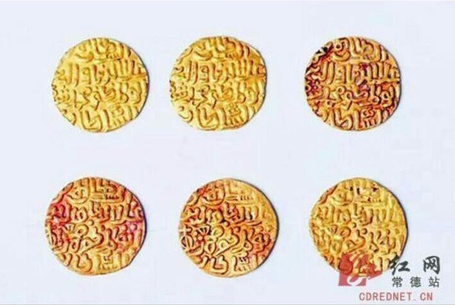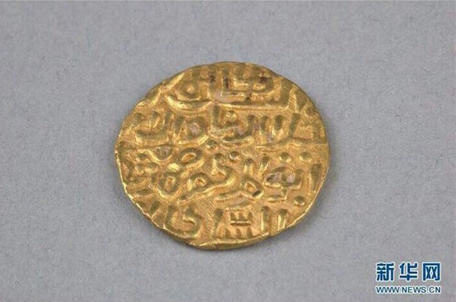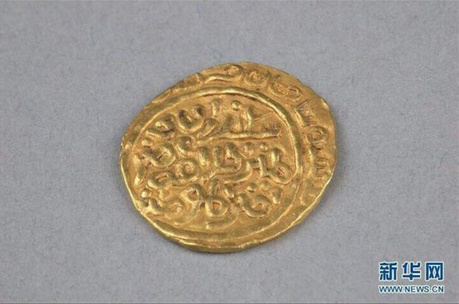Undeciphered inscriptions
« previous post | next post »
In the 60s of the last century, six gold coins were unearthed at Jinshi, Hunan, China. They are said by the local museum to be Indian coins struck by the Delhi Sultanate (1206-1526). The obverse apparently carries the title and name of the ruler while the reverse is thought to be written in a form of Arabic script. So far no one has been able to read the inscriptions on the reverse. The museum is offering a reward of 10,000 yuan (US$1,531.36) to anyone who can read the inscriptions.



Victor Mair said,
February 17, 2016 @ 4:10 pm
To get us started, a colleague who spent 30 seconds on a break to take a quick, cursory look reports:
=====
"Sultan someone Zafar ‘Ala ad-dawla wa’d-din something something." That would be the king’s name in which they were minted (although those are titles, not names).
=====
He says that they are actually easy to read but that we need better photos / scans to read them in their entirety. I'm trying to obtain them.
Meanwhile, although my colleague is not a numismatist, he states:
=====
The script strikes me, at first glance, as very standard low quality writing found in regional mints across South and Central Asia.
=====
Victor Mair said,
February 17, 2016 @ 4:36 pm
A better photo here:
http://www.bbc.com/news/blogs-news-from-elsewhere-35595138
Victor Mair said,
February 17, 2016 @ 6:36 pm
I now have more photographs if anyone would like to see them.
Victor Mair said,
February 17, 2016 @ 8:32 pm
Preliminary results are starting to come in. Will probably post some later this evening.
Victor Mair said,
February 17, 2016 @ 8:44 pm
From Pushkar Sohoni:
The coins are from the reign of 'Ala al-din Muhammad (1296-1316) who was the sultan of Delhi known for his conquests across the whole sub-continent. The script is standard naskh as used on sultanate coins, and the legend on the reverse has an innovation where the sultan called himself the "second Alexander."
The legend reads "Al-sultan al-a'zam 'ala al-duniya wa'l-din abu'l muzaffar muhammad shah al-sultan" with "Sikandar al-thani yamin al-khilafa nasir amir al-mu'minin" on the reverse.
The coins are listed in two recent catalogues:
Stan Goron and J.P. Goenka, The Coins of the Indian Sultanates (2001) – # D220
Dilip Rajgor, Standard Catalog of Sultanate Coins in India (1991) – # 998
thunk said,
February 18, 2016 @ 2:29 am
Peng Jia really doesn't seem to have been trying that hard…
Victor Mair said,
February 18, 2016 @ 8:44 am
@thunk
You're right. Within hours after posting (at 3:14 p.m. yesterday, i.e., 2/17/16), several people wrote to me saying that the script is definitely Perso-Arabic and that the coins "belong to a mint associated with the Sultanate empire in Central and South Asia". Others very quickly began to give tentative, partial readings. By 8:44 p.m., Pushkar Sohoni, the South Asian Librarian at Penn, gave what appears to be a definitive decipherment, complete with helpful commentary and annotation, including references to published examples of similar coins.
BTW, there are people in China (e.g., in Shanghai, in Beijing, and in Xinjiang, some of whom I know) who are supposed to be experts in Perso-Arabic script, and Peng Jia claims that he at least contacted people in Xinjiang, so it's difficult to understand why they were unable to decipher the script. At least half-a-dozen respondents to the LL quiz told me that the inscriptions were relatively easy to read.
Another thing that is a bit puzzling to me is that the Chinese announcement of the contest to find someone who could decipher the inscriptions referred to the script as "Kēfēitǐ 科菲体", by which I think they meant "Kufic". ("Kufic" is normally transcribed in Chinese as Kùfǎtǐ 库法体.)
That really puzzled me, since — although I am by no means an expert in Arabic epigraphy — I am familiar enough with Arabic calligraphy to know that the inscriptions did not look at all like Kufic script, which is decidedly angular and much too early for these Sultanate coins, but were rather more on the order of standard Naskh, which is more rounded. Naskh gave rise to the Nasta'līq script, which is used for writing Urdu, Persian, Punjabi, and Kashmiri, as well as sometimes Pashto and Uyghur.
Highly recommended reading:
Brian Spooner and William L. Hanaway, ed., Literacy in the Persianate World: Writing and the Social Order (Philadelphia: Distributed for the University of Pennsylvania Museum of Archaeology and Anthropology by the University of Pennsylvania Press, 2012).
Table of contents here.
The last chapter — titled "Persian Scribes (munshi) and Chinese Literati (ru). The Power and Prestige of Fine Writing (adab/wenzhang)" — is by yours truly.
Now I'm going to try to contact the museum in Jinshi, Hunan to claim the 10,000 yuan reward for Pushkar. Wish me luck, everybody!
Leo said,
February 18, 2016 @ 10:05 am
Pardon the ms paint quality, but in case anyone is interested in seeing which words are which:
http://imgur.com/a/VqJ2m
languagehat said,
February 18, 2016 @ 10:17 am
Leo: Thanks, that's very useful!
Leo said,
February 18, 2016 @ 12:23 pm
It seems most likely in comparison with other coins that the outside would say something like "duriba hadhihi al-fiddah/al-sikkah bi-hadrat dihli fi sanah ___" (this coin was struck in Delhi in the year ___." I'm 10% convinced I see "…'ashar wa sab'ami'a" (ten and seven hundred, i.e. in the 710s or about 1310-1319 CE) there at the coin's 3 o'clock to 1 o'clock, comparing with writing on other coins from the same time. I think that's the "dur" of "duriba" at twelve o'clock.
Victor Mair said,
February 18, 2016 @ 1:22 pm
More with respect to Kufic:
http://www.harvardartmuseums.org/art/317875
"As in this example, most of the coins of the Delhi Sultans no longer employed the Kufic Script, instead favoring a medieval script."
Alexander Akin said,
February 20, 2016 @ 5:26 pm
These are indeed easily deciphered, and available in many references including Goron and Goenka's catalog of Sultanate coins. However, the slightly garbled script indicates that they are imitations, possibly made in Central Asia
Spenser said,
February 20, 2016 @ 6:49 pm
There really isn't much to decipher.
You can find these coins (GOLD TANKA) of the time of Ala al-Din Muhammad Shah, (695-715 H/1296-1316 AD)
http://tinypic.com/r/2l9mxib/9
It looks like someone else has already done something similar though :)
I don't get why they were seeking Chinese experts for Indian coins though. It seems somewhat silly. Also, these are only the front of the coins visible – not being able to see the reverse side of the coins makes it difficult to really help with anything.
I have contacted the museum and they told me to just e-mail them information. They didn't seem interested in talking.
Spenser said,
February 20, 2016 @ 7:09 pm
I think the difficult part will be dating these coins.
The inscriptions are easy.
Victor Mair said,
February 20, 2016 @ 7:28 pm
@Spenser
The coins were deciphered on 2/17/16 8:44 p.m. by Pushkar Sohoni. We are directly in touch with the museum and are trying to collect the reward for Pushkar. As I said before, wish us luck.
Victor Mair said,
February 22, 2016 @ 11:15 am
As I noted in the previous comment, we are in touch with the Jinshi Museum and are attempting to collect the reward for Pushkar Sohoni. If we are successful, I will make a special announcement to that effect.